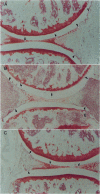Abstract
Leukotriene B4 (LTB4) is a product of the 5-lipoxygenase pathway of arachidonic acid metabolism. LTB4 is a potent chemotactic factor for neutrophils and has been postulated to play an important role in a variety of pathological conditions including rheumatoid arthritis (RA), psoriasis, and inflammatory bowel disease. The role of LTB4 in such diseases has not yet been defined but in this paper we provide direct evidence that LTB4 plays a critical role in a murine model of RA. CP-105,696, (+)-1-(3S,4R)-[3-(4-phenylbenzyl)- 4-hydroxychroman-7-yl]cyclopentane carboxylic acid, is an LTB4 receptor antagonist that inhibits LTB4 binding to human neutrophil membranes with an IC50 of 3.7 nM and inhibits LTB4-induced chemotaxis of these cells with an IC50 of 5.2 nM. CP-105,696 inhibits LTB4-induced neutrophil influx in mouse skin when administered orally with an ED50 of 4.2 mg/kg. CP-105,696 had a dramatic effect on both the clinical symptoms and histological changes of murine collagen-induced arthritis when administered at doses of 0.3-10 mg/kg. Inhibition was not associated with suppression of the humoral immune response to collagen and was equally effective if drug treatment was commenced just prior to the onset of arthritis or throughout the experiment. These results suggest that LTB4 receptor antagonists may be effective therapeutic agents for the treatment of RA.
Full text
PDF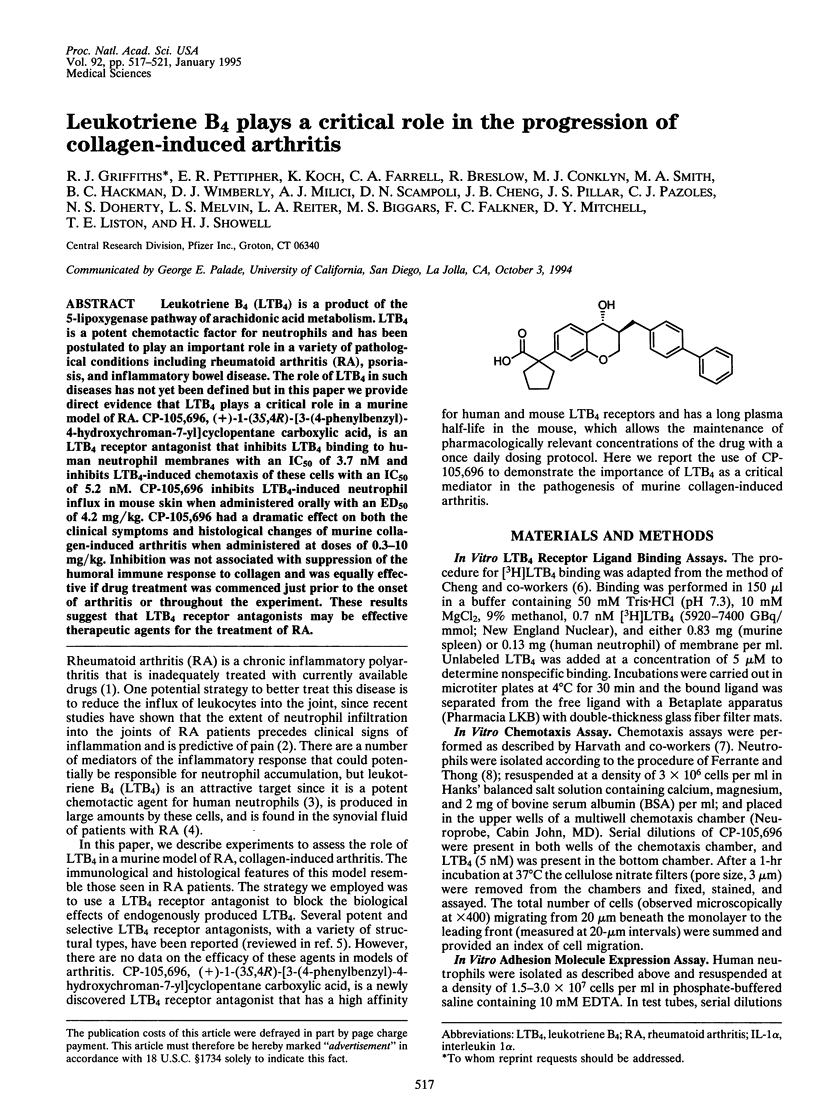
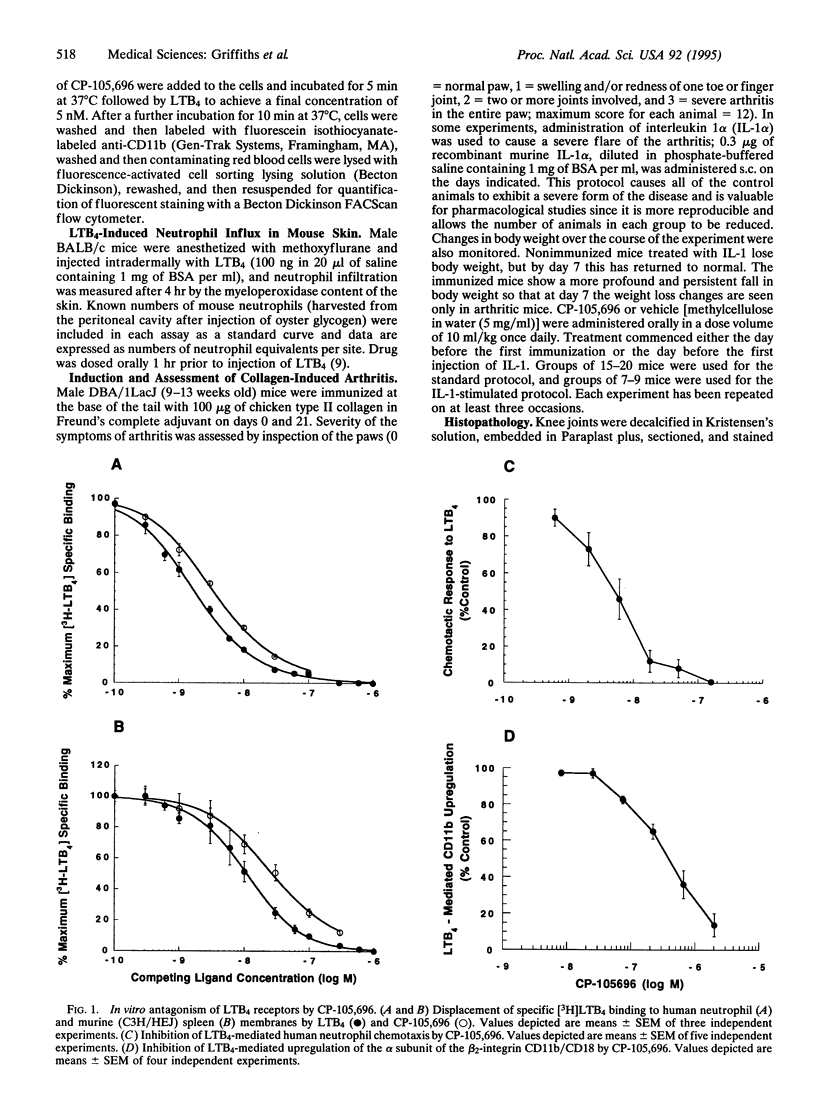
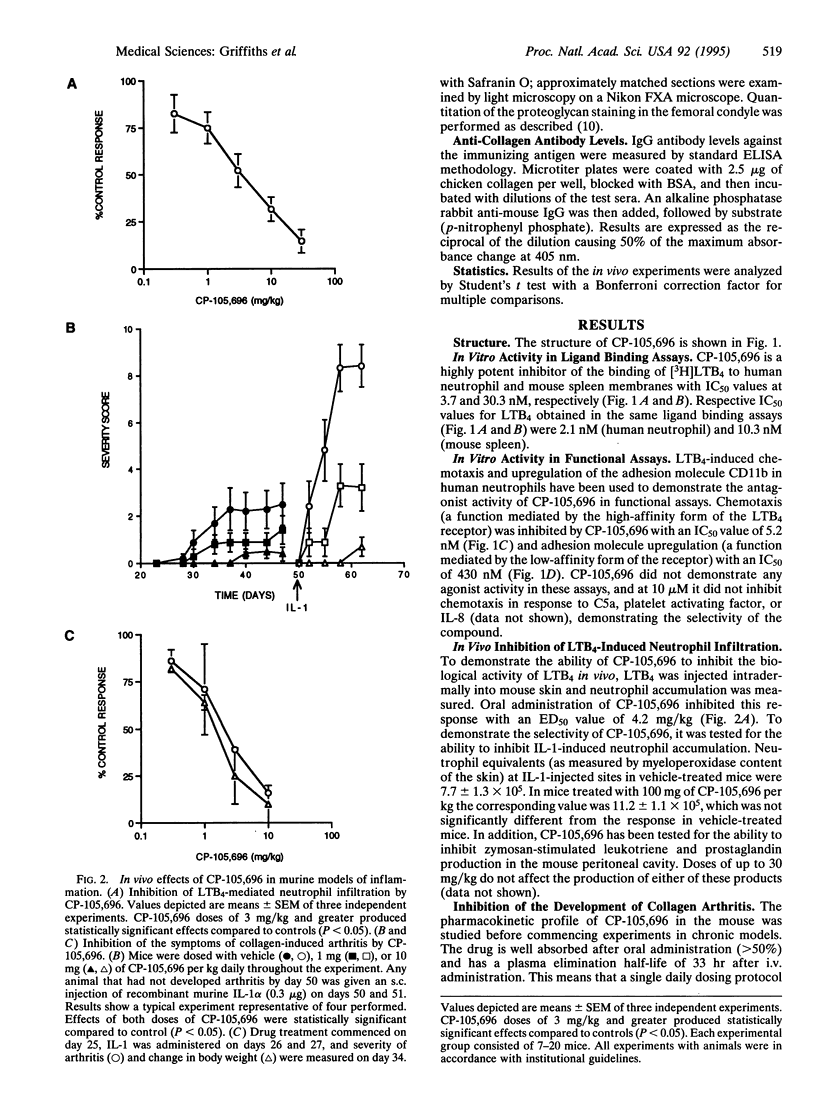
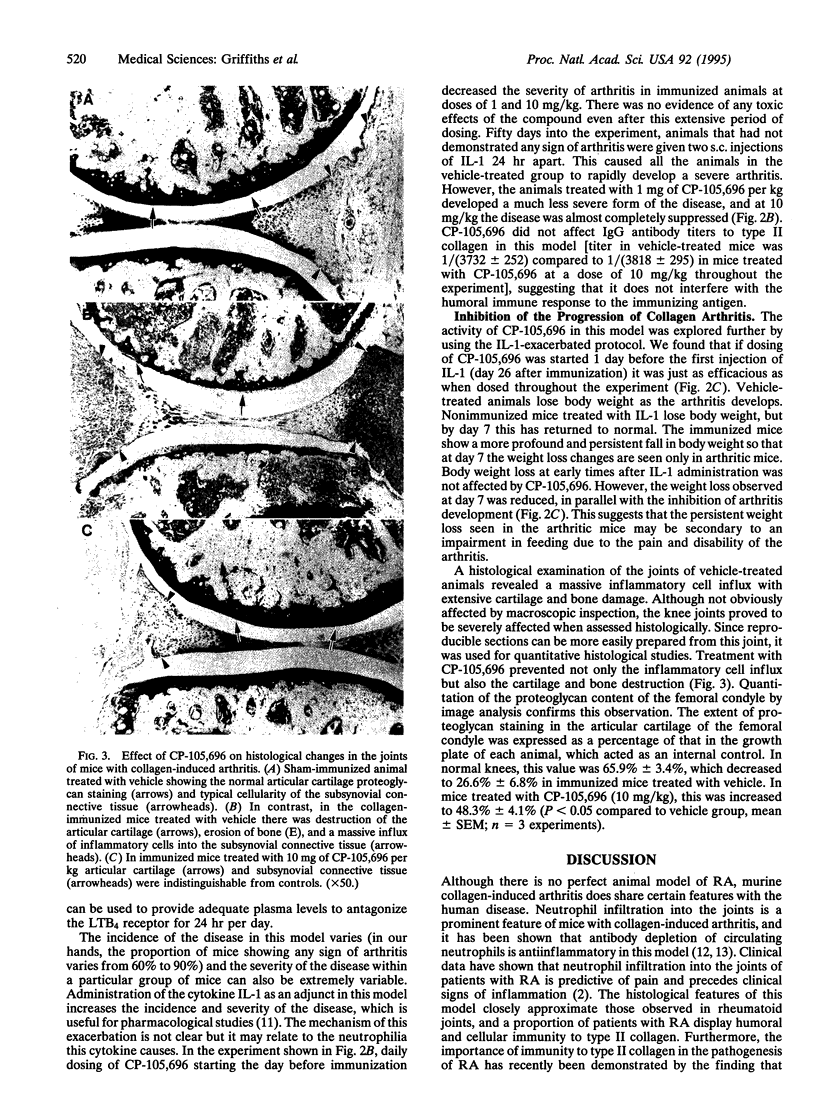
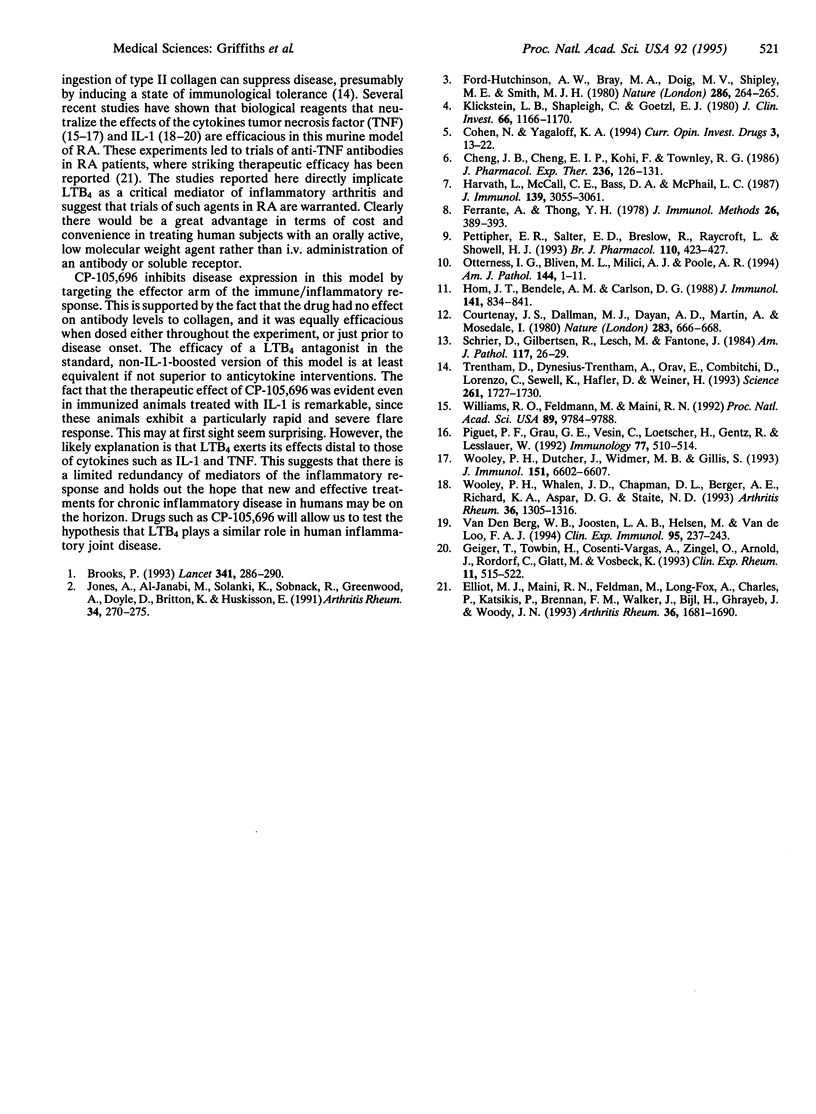
Images in this article
Selected References
These references are in PubMed. This may not be the complete list of references from this article.
- Brooks P. M. Clinical management of rheumatoid arthritis. Lancet. 1993 Jan 30;341(8840):286–290. doi: 10.1016/0140-6736(93)92628-7. [DOI] [PubMed] [Google Scholar]
- Chang M., Tsuchiya K., Batchelor R. H., Rabinovitch P. S., Kulander B. G., Haggitt R. C., Burmer G. C. Deletion mapping of chromosome 8p in colorectal carcinoma and dysplasia arising in ulcerative colitis, prostatic carcinoma, and malignant fibrous histiocytomas. Am J Pathol. 1994 Jan;144(1):1–6. [PMC free article] [PubMed] [Google Scholar]
- Cheng J. B., Cheng E. I., Kohi F., Townley R. G. [3H]leukotriene B4 binding to the guinea-pig spleen membrane preparation: a rich tissue source for a high-affinity leukotriene B4 receptor site. J Pharmacol Exp Ther. 1986 Jan;236(1):126–132. [PubMed] [Google Scholar]
- Courtenay J. S., Dallman M. J., Dayan A. D., Martin A., Mosedale B. Immunisation against heterologous type II collagen induces arthritis in mice. Nature. 1980 Feb 14;283(5748):666–668. doi: 10.1038/283666a0. [DOI] [PubMed] [Google Scholar]
- Elliott M. J., Maini R. N., Feldmann M., Long-Fox A., Charles P., Katsikis P., Brennan F. M., Walker J., Bijl H., Ghrayeb J. Treatment of rheumatoid arthritis with chimeric monoclonal antibodies to tumor necrosis factor alpha. Arthritis Rheum. 1993 Dec;36(12):1681–1690. doi: 10.1002/art.1780361206. [DOI] [PubMed] [Google Scholar]
- Ferrante A., Thong Y. H. A rapid one-step procedure for purification of mononuclear and polymorphonuclear leukocytes from human blood using a modification of the Hypaque-Ficoll technique. J Immunol Methods. 1978;24(3-4):389–393. doi: 10.1016/0022-1759(78)90143-6. [DOI] [PubMed] [Google Scholar]
- Ford-Hutchinson A. W., Bray M. A., Doig M. V., Shipley M. E., Smith M. J. Leukotriene B, a potent chemokinetic and aggregating substance released from polymorphonuclear leukocytes. Nature. 1980 Jul 17;286(5770):264–265. doi: 10.1038/286264a0. [DOI] [PubMed] [Google Scholar]
- Geiger T., Towbin H., Cosenti-Vargas A., Zingel O., Arnold J., Rordorf C., Glatt M., Vosbeck K. Neutralization of interleukin-1 beta activity in vivo with a monoclonal antibody alleviates collagen-induced arthritis in DBA/1 mice and prevents the associated acute-phase response. Clin Exp Rheumatol. 1993 Sep-Oct;11(5):515–522. [PubMed] [Google Scholar]
- Harvath L., McCall C. E., Bass D. A., McPhail L. C. Inhibition of human neutrophil chemotaxis by the protein kinase inhibitor, 1-(5-isoquinolinesulfonyl) piperazine. J Immunol. 1987 Nov 1;139(9):3055–3061. [PubMed] [Google Scholar]
- Hom J. T., Bendele A. M., Carlson D. G. In vivo administration with IL-1 accelerates the development of collagen-induced arthritis in mice. J Immunol. 1988 Aug 1;141(3):834–841. [PubMed] [Google Scholar]
- Jones A. K., al-Janabi M. A., Solanki K., Sobnack R., Greenwood A., Doyle D. V., Britton K. E., Huskisson E. C. In vivo leukocyte migration in arthritis. Arthritis Rheum. 1991 Mar;34(3):270–275. doi: 10.1002/art.1780340304. [DOI] [PubMed] [Google Scholar]
- Klickstein L. B., Shapleigh C., Goetzl E. J. Lipoxygenation of arachidonic acid as a source of polymorphonuclear leukocyte chemotactic factors in synovial fluid and tissue in rheumatoid arthritis and spondyloarthritis. J Clin Invest. 1980 Nov;66(5):1166–1170. doi: 10.1172/JCI109947. [DOI] [PMC free article] [PubMed] [Google Scholar]
- Pettipher E. R., Salter E. D., Breslow R., Raycroft L., Showell H. J. Specific inhibition of leukotriene B4 (LTB4)-induced neutrophil emigration by 20-hydroxy LTB4: implications for the regulation of inflammatory responses. Br J Pharmacol. 1993 Sep;110(1):423–427. doi: 10.1111/j.1476-5381.1993.tb13827.x. [DOI] [PMC free article] [PubMed] [Google Scholar]
- Piguet P. F., Grau G. E., Vesin C., Loetscher H., Gentz R., Lesslauer W. Evolution of collagen arthritis in mice is arrested by treatment with anti-tumour necrosis factor (TNF) antibody or a recombinant soluble TNF receptor. Immunology. 1992 Dec;77(4):510–514. [PMC free article] [PubMed] [Google Scholar]
- Schrier D., Gilbertsen R. B., Lesch M., Fantone J. The role of neutrophils in type II collagen-induced arthritis in rats. Am J Pathol. 1984 Oct;117(1):26–29. [PMC free article] [PubMed] [Google Scholar]
- Trentham D. E., Dynesius-Trentham R. A., Orav E. J., Combitchi D., Lorenzo C., Sewell K. L., Hafler D. A., Weiner H. L. Effects of oral administration of type II collagen on rheumatoid arthritis. Science. 1993 Sep 24;261(5129):1727–1730. doi: 10.1126/science.8378772. [DOI] [PubMed] [Google Scholar]
- Williams R. O., Feldmann M., Maini R. N. Anti-tumor necrosis factor ameliorates joint disease in murine collagen-induced arthritis. Proc Natl Acad Sci U S A. 1992 Oct 15;89(20):9784–9788. doi: 10.1073/pnas.89.20.9784. [DOI] [PMC free article] [PubMed] [Google Scholar]
- Wooley P. H., Dutcher J., Widmer M. B., Gillis S. Influence of a recombinant human soluble tumor necrosis factor receptor FC fusion protein on type II collagen-induced arthritis in mice. J Immunol. 1993 Dec 1;151(11):6602–6607. [PubMed] [Google Scholar]
- Wooley P. H., Whalen J. D., Chapman D. L., Berger A. E., Richard K. A., Aspar D. G., Staite N. D. The effect of an interleukin-1 receptor antagonist protein on type II collagen-induced arthritis and antigen-induced arthritis in mice. Arthritis Rheum. 1993 Sep;36(9):1305–1314. doi: 10.1002/art.1780360915. [DOI] [PubMed] [Google Scholar]
- van den Berg W. B., Joosten L. A., Helsen M., van de Loo F. A. Amelioration of established murine collagen-induced arthritis with anti-IL-1 treatment. Clin Exp Immunol. 1994 Feb;95(2):237–243. doi: 10.1111/j.1365-2249.1994.tb06517.x. [DOI] [PMC free article] [PubMed] [Google Scholar]



